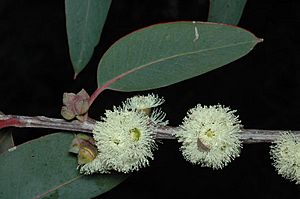Bolivia Hill stringybark facts for kids
Quick facts for kids Bolivia Hill stringybark |
|
|---|---|
 |
|
| Flowers and buds of Eucalyptus boliviana | |
| Scientific classification | |
| Genus: |
Eucalyptus
|
| Species: |
boliviana
|
The Bolivia Hill stringybark (scientific name: Eucalyptus boliviana) is a special type of plant. It can be a small bush, a "mallee" (which means it has many stems growing from the ground), or sometimes even a small tree. You can only find it in a tiny part of northern New South Wales, Australia. This plant is called a "stringybark" because its bark looks like strings. It has unique stems with four sides, leaves shaped like wide spearheads, and its yellow flowers grow in groups of seven. After flowering, it produces fruit that looks like a half-sphere or a wide funnel.
What Does It Look Like?
The Bolivia Hill stringybark can grow as a shrub or a mallee, reaching about 5 metres (16 ft) tall. Sometimes, it can even become a small tree, growing up to 12 metres (39 ft) high.
- Bark: The bark on its main trunk and bigger branches is greyish and stringy. This is why it's called a "stringybark"!
- Stems: Its thinner stems are easy to spot because they have four clear sides, almost like they have little "wings" on each edge.
- Young Leaves: When the plant is young, or when new shoots grow from the base (called "coppice regrowth"), the stems are square. Their leaves can be oval, egg-shaped, or wide and spear-shaped. These young leaves are usually 65–110 mm (2.6–4.3 in) long and 30–65 mm (1.2–2.6 in) wide. They also have a stalk, called a petiole, that connects them to the stem.
- Adult Leaves: The leaves on older plants are wide and spear-shaped. At first, they are a dull bluish-green, but then they become a shiny green on both sides. These adult leaves are typically 80–160 mm (3.1–6.3 in) long and 30–50 mm (1–2 in) wide. Their petioles are about 12–30 mm (0.5–1 in) long.
- Flower Buds: The flower buds grow in groups of seven. They appear in the "axils" of the leaves, which is the angle between the leaf and the stem. Each group of buds is on a short stalk called a peduncle, which is about 4–10 mm (0.2–0.4 in) long. The individual flowers themselves don't have stalks; they are "sessile" (meaning they sit directly on the peduncle). Mature buds are oval or broadly spindle-shaped, with a cone-shaped cap called an "operculum."
- Flowers: This plant mainly flowers in September, and its flowers are bright yellow.
- Fruit: The fruit also grows directly on the stem (sessile). It's shaped like a half-sphere or a wide funnel, about 5–6 mm (0.20–0.24 in) long and 10–15 mm (0.39–0.59 in) wide. The "valves" (parts that open to release seeds) are usually level with the rim of the fruit or stick out slightly.
How It Got Its Name
The Bolivia Hill stringybark was first officially described in 2001 by two botanists, John Beaumont Williams and Ken Hill. They published their description in a science journal called Telopea.
The second part of its scientific name, boliviana, comes from the place where this plant is found: Bolivia Hill.
Where Does It Live?
This special eucalypt only grows in one specific place: Bolivia Hill. This area is located between the towns of Glen Innes and Tenterfield in New South Wales. It likes to grow in woodlands, especially among granite rocks.
Is It Protected?
Yes, the Bolivia Hill stringybark is considered "vulnerable." This means it's at risk of becoming endangered if we don't protect it. The New South Wales Government has listed it as vulnerable under their Biodiversity Conservation Act 2016.

